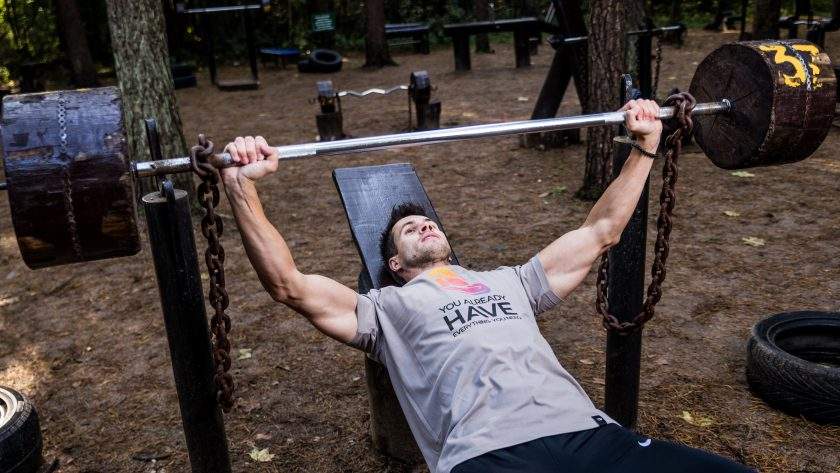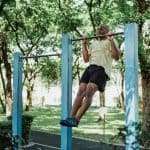A push day workout is a popular way to build muscle and strength in the upper body. They typically focus on exercises that target the chest, shoulders, and triceps. By following a push day routine, individuals can effectively develop these muscles and improve their overall fitness.
Understanding push day workouts is essential before diving into designing a routine. A push day is part of the push-pull-legs (PPL) routine, which divides the major muscle groups to be trained on separate days. During a push day, individuals focus specifically on push exercises and the muscles involved in them. This typically means compound pressing exercises like the bench press, overhead press, and push-ups, as well as isolation exercises for push muscles, like tricep extensions and lateral raises.
Designing a push day routine is crucial to ensure that individuals get the most out of their workout. It is important to include essential push day exercises that target the chest, shoulders, and triceps. Additionally, safety measures and precautions should be taken to prevent injuries during exercise. By following a well-designed push day routine, individuals can achieve their fitness goals and improve their overall health and wellness.
Key Takeaways
- Push day workouts focus on exercises that target the chest, shoulders, and triceps.
- A push day is part of the push-pull-legs (PPL) routine, which divides the major muscle groups to be trained on separate days.
- Designing a push day routine with essential exercises and safety precautions is crucial for achieving fitness goals and improving overall health and wellness.
Understanding Push Day Workout
Push day workout is a type of resistance training that focuses on developing the muscles in the upper body that are responsible for pushing movements. These movements include pushing a weight away from the body, such as a bench press or shoulder press. A push day workout routine typically targets the chest, shoulders, and triceps muscles.
Goal of a Push Day Workout
The goal of a push day workout is to build strength and muscle mass in the upper body. By focusing on these specific muscle groups, push day workouts help to prevent over-training and neglecting other muscle groups. It is important to note that push day workouts should be balanced with pull day workouts, which focus on the muscles responsible for pulling movements, such as the back and biceps.
Push day workouts can be tailored to suit different fitness levels and goals. Beginners may start with lighter weights and fewer sets, while more advanced lifters may increase the weight and number of sets to challenge themselves. It is important to gradually increase the weight and intensity of the workout to avoid injury.
Designing a Push Day Workout Plan
When designing a push day workout plan, it is important to choose exercises that target the chest, shoulders, and triceps muscles. Some popular exercises include bench press, overhead press, push-ups, dips, and lateral raises. It is also important to vary the exercises to prevent boredom and stimulate muscle growth.
In summary, push day workouts are an effective way to develop strength and muscle mass in the upper body. By targeting the chest, shoulders, and triceps muscles, push day workouts help to prevent over-training and neglecting other muscle groups. When designing a push day workout plan, it is important to choose exercises that target these specific muscle groups and gradually increase the weight and intensity of the workout.
Muscles Involved in a Push Day Workout
Push day workouts are designed to target specific muscle groups in the upper body, lower body, and core. By focusing on these muscle groups, individuals can improve their strength, build muscle mass, and enhance their overall fitness level. Here are the main muscle groups involved in push day workouts:
Upper Body Muscles
The upper body muscles are the primary focus of push day workouts. These muscles include the chest, back, shoulders, biceps, and triceps. The chest muscles are the most significant muscle group in the upper body and are responsible for pushing movements. The back muscles are also involved in pushing movements and work in conjunction with the chest muscles to provide stability during exercises like bench presses and push-ups. The shoulder muscles are responsible for overhead pushing movements, and the biceps and triceps are responsible for arm flexion and extension.
Lower Body Muscles
Although push day workouts are primarily focused on the upper body, they also involve some lower body muscles. The lower body muscles involved in push day workouts are the quadriceps and glutes. These muscles are responsible for providing stability and power during exercises like squats and lunges.
Core Muscles
The core muscles are involved in almost every exercise and provide stability and support for the entire body. During push day workouts, the core muscles are engaged to maintain proper form and stability during exercises like planks and push-ups. The major muscle groups involved in the core are the rectus abdominis, obliques, and erector spinae.
In summary, push day workouts target specific muscle groups in the upper body, lower body, and core. By incorporating exercises that engage these muscle groups, individuals can improve their strength, build muscle mass, and enhance their overall fitness level.
Essential Push Day Workout Exercises
When it comes to building a strong upper body, push day exercises are essential. These exercises target the chest, shoulders, and triceps, helping to build muscle and increase strength. To ensure a well-rounded workout, it’s important to include a variety of exercises that target different muscle groups. Here are some essential push day exercises to consider:
Bench Press Variations
The bench press is a classic push day exercise that targets the chest, shoulders, and triceps. There are several variations of the bench press that you can incorporate into your workout, including the barbell bench press, dumbbell bench press, and incline bench press. Each variation targets slightly different muscles and can help to prevent boredom in your routine.
Shoulder Press Variations
Shoulder presses are another essential push day exercise that target the shoulders and triceps. There are several variations of the shoulder press, including the dumbbell shoulder press and the overhead press. Incorporating different variations into your workout can help to prevent plateauing and ensure that you continue to make progress.
Tricep Exercises
The triceps are often neglected in push day workouts, but they are an essential part of building a strong upper body. Tricep exercises like tricep pushdowns and dips can help to target this muscle group and improve overall arm strength.
Push-Up Variations
Push-ups are a classic bodyweight exercise that can be modified to target different muscle groups. Incorporating push-up variations like diamond push-ups or decline push-ups can help to target different areas of the chest and triceps.
Overall, incorporating a variety of compound exercises into your push day workout can help to improve overall upper body strength and muscle growth. By targeting different muscle groups and incorporating different variations of exercises, you can ensure a well-rounded and effective workout.
Designing Your Push Day Workout Routine
When designing a push day routine, there are several factors to consider, including sets and reps, training volume, warm-up, and recovery. By optimizing these elements, you can ensure that your push day workouts are effective and efficient in building muscle and strength.
Sets and Reps for a Push Day Workout
The number of sets and reps you perform during your push day workout can have a significant impact on your results. Generally, it’s recommended to perform 3-4 sets of 8-12 reps per exercise. However, this can vary depending on your fitness level and specific goals.
Training Volume
Training volume refers to the total amount of work you perform during your training sessions. To optimize your push day routine, it’s important to find the right balance between volume and intensity. This can be achieved by adjusting the number of exercises, sets, and reps you perform.
Warm-Up and Recovery
Proper warm-up and recovery are essential for preventing injury and maximizing your performance during your push day workout. Before starting your workout, it’s recommended to perform dynamic stretching and mobility exercises to prepare your muscles for the upcoming workout. After your workout, be sure to stretch and foam roll to aid in recovery and reduce muscle soreness.
When incorporating push day workouts into your training split, it’s important to consider the push/pull/legs split. This involves dividing your training sessions into three categories: push exercises (chest, shoulders, triceps), pull exercises (back, biceps), and leg exercises. By rotating between these categories, you can ensure that you’re targeting all major muscle groups while allowing for proper recovery time.
In summary, designing an effective push day routine involves finding the right balance between sets and reps, training volume, warm-up, and recovery. By optimizing these elements and incorporating them into a push/pull/legs split routine, you can maximize your gains and achieve your fitness goals.
Benefits of a Push Day Workout
Push day workout is a popular workout routine that targets the chest, shoulders, and triceps muscles. Incorporating push day workout in your exercise regimen can have several benefits. Here are some of the benefits of push day workout:
1. Builds Strength and Size
Push day workout focuses on compound exercises like bench press, overhead press, and dips that target multiple muscle groups. These exercises help to build strength and size in the chest, shoulders, and triceps muscles. By increasing the weight and intensity of these exercises, you can progressively overload your muscles, leading to muscle hypertrophy and gains in strength.
2. Improves Muscle Definition
Push day workout is an effective way to improve muscle definition in the chest, shoulders, and triceps muscles. By targeting these muscle groups, you can increase muscle size and reduce body fat, which can lead to a more defined and toned physique.
3. Increases Metabolic Rate
Push day workout is a high-intensity workout that can increase your metabolic rate. By engaging multiple muscle groups, your body burns more calories during and after the workout. This can help you to lose weight and improve overall fitness.
4. Enhances Athletic Performance
Push day workout can enhance athletic performance by improving upper body strength and power. By targeting the chest, shoulders, and triceps muscles, push day workout can improve performance in sports that require upper body strength, such as basketball, volleyball, and swimming.
In conclusion, push day workout is an effective way to build strength, size, and muscle definition in the chest, shoulders, and triceps muscles. It can also increase your metabolic rate and enhance athletic performance. By incorporating push day workout in your exercise regimen, you can achieve your fitness goals and take your workout to the next level.
Safety Measures and Precautions
When performing a push day workout, it is important to take safety measures and precautions to prevent injuries. Here are some tips to keep in mind:
Proper Form
Maintaining proper form is crucial to avoid stress on joints and muscles. When performing exercises like push-ups and bench presses, make sure to keep your elbows close to your body. This helps to prevent unnecessary strain on the elbow joint. Additionally, avoid locking your elbows as this can cause stress on the joint.
Gradual Progression
It is important to gradually increase the intensity of your workouts. Avoid jumping into a high-intensity workout without proper preparation. Gradual progression allows your body to adapt to the increased stress and helps to prevent injuries.
Warm-up and Cool-down
Warming up before a workout helps to increase blood flow to the muscles and prepares them for the upcoming stress. Cooling down after a workout helps to prevent muscle soreness and stiffness. Make sure to include a warm-up and cool-down session in your push day workout routine.
Proper Equipment
Using proper equipment is essential for a safe workout. Make sure to wear comfortable and supportive shoes that provide good traction. Additionally, use a weightlifting belt when performing heavy lifts to provide additional support to your lower back.
Listen to Your Body
Lastly, it is important to listen to your body. If you feel pain or discomfort during a workout, stop immediately. Pushing through pain can cause serious injuries. Additionally, avoid overtraining as this can cause stress on your muscles and joints.
By following these safety measures and precautions, you can perform a push day workout safely and effectively.
Role of Nutrition and Rest in a Push Day Workout
Nutrition and rest play a crucial role in achieving optimal results during a push day workout. Proper nutrition and adequate rest are essential for muscle recovery and growth. Here are some tips to help you optimize your nutrition and rest for a successful push day workout.
Nutrition
Before a push day workout, it is important to fuel your body with the right nutrients. A balanced meal containing carbohydrates, protein, and healthy fats can provide the necessary energy for a successful workout. Some good pre-workout meal options include oatmeal with berries and nuts, a turkey sandwich on whole-grain bread, or a smoothie with protein powder and fruits.
During the workout, it is important to stay hydrated. Drinking water or a sports drink can help replace fluids lost through sweating. Additionally, consuming a protein shake or snack after the workout can help repair and rebuild muscle tissue. Some good post-workout snack options include a protein shake, Greek yogurt with fruit, or a turkey and cheese wrap.
Rest
Rest is equally important as nutrition for muscle recovery and growth. During rest days, the muscles repair and rebuild, which helps to prevent injury and improve overall performance. Adequate sleep is also essential for muscle recovery. It is recommended to get at least 7-8 hours of sleep per night to allow the body to recover and prepare for the next workout.
In addition to sleep, active recovery exercises such as yoga, stretching, or light cardio can also help with muscle recovery. These exercises increase blood flow to the muscles, which can help reduce soreness and improve flexibility.
Other Factors
Other factors such as stress and caffeine intake can also affect muscle recovery and performance. High levels of stress can lead to increased cortisol levels, which can negatively impact muscle growth. Drinking too much caffeine can also lead to dehydration, which can affect performance during the workout.
Incorporating stress-reducing activities such as meditation or deep breathing exercises can help reduce cortisol levels and improve overall performance. Additionally, limiting caffeine intake and drinking plenty of water can help prevent dehydration and improve overall health.
In conclusion, proper nutrition and rest are essential for a successful push day workout. Incorporating a balanced diet, staying hydrated, getting adequate sleep, and reducing stress levels can help optimize muscle recovery and growth.
Frequently Asked Questions
What is the difference between push day and pull day?
Push day and pull day are two different workout routines that focus on different muscles. Push day exercises target the muscles used for pushing movements, such as the chest, triceps, and shoulders. Pull day exercises, on the other hand, target the muscles used for pulling movements, such as the back, biceps, and forearms.
What are some effective warm-up exercises for push day?
Effective warm-up exercises for push day include light cardio, such as jumping jacks or jogging in place, and dynamic stretching exercises that target the muscles you will be using during your workout. Examples of dynamic stretching exercises include arm circles, shoulder rolls, and trunk rotations.
What are some home push workouts that require no equipment?
There are many effective push workouts that can be done at home without any equipment. Examples include push-ups, bench dips, tricep dips, and pike push-ups. These exercises can be modified to increase or decrease the difficulty level, depending on your fitness level.
What is the ideal number of exercises for a push day workout?
The ideal number of exercises for a push day workout depends on your fitness level and goals. Generally, it is recommended to perform 3-5 exercises per muscle group, with 3-4 sets of 8-12 reps per exercise.
How should I structure my push day workout for maximum effectiveness?
To structure your push day workout for maximum effectiveness, start with compound exercises that target multiple muscle groups, such as bench press or push-ups. Follow this with isolation exercises that target specific muscles, such as tricep extensions or lateral raises. Finish your workout with a cool-down period that includes stretching exercises.
How many sets and reps should I do for each exercise on push day?
The number of sets and reps you should do for each exercise on push day depends on your fitness level and goals. Generally, it is recommended to perform 3-4 sets of 8-12 reps per exercise, with a rest period of 60-90 seconds between sets. However, if you are looking to build strength, you may want to perform fewer reps with heavier weights, while if you are looking to build endurance, you may want to perform more reps with lighter weights.
Other Posts You May Enjoy!
- JM Press: The Ultimate Guide to Perfecting Your Triceps

- Lat Pullover: A Complete Guide to Building a Strong Back

- The Benefits and Proper Usage of a Chest Fly Machine | The Ultimate Guide

- Incline Dumbbell Fly: How to Properly Execute for Maximum Chest Development

- Cable Chest Workout: Exercises and Tips for Maximum Results

EXPAND YOUR MIND
Join the best newsletter that you never knew you needed. You’ll get emails containing grooming tips, new blog posts, product launches, giveaways, and motivation to help you Keep on Keeping on.



